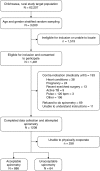Noncommunicable Respiratory Disease and Air Pollution Exposure in Malawi (CAPS). A Cross-Sectional Study
- PMID: 30141966
- PMCID: PMC6396863
- DOI: 10.1164/rccm.201805-0936OC
Noncommunicable Respiratory Disease and Air Pollution Exposure in Malawi (CAPS). A Cross-Sectional Study
Abstract
Rationale: Noncommunicable respiratory diseases and exposure to air pollution are thought to be important contributors to morbidity and mortality in sub-Saharan African adults.
Objectives: We set out to explore the prevalence and determinants of noncommunicable respiratory disease among adults living in Chikhwawa District, Malawi.
Methods: We performed a cross-sectional study among adults in communities participating in a randomized controlled trial of a cleaner-burning biomass-fueled cookstove intervention (CAPS [Cooking and Pneumonia Study]) in rural Malawi. We assessed chronic respiratory symptoms, spirometric abnormalities, and personal exposure to air pollution (particulate matter <2.5 μm in aerodynamic diameter [PM2.5] and carbon monoxide [CO]). Weighted prevalence estimates were calculated; multivariable and intention-to-treat analyses were done.
Measurements and main results: One thousand four hundred eighty-one participants (mean [SD] age, 43.8 [17.8] yr; 57% female) were recruited. The prevalence of chronic respiratory symptoms, spirometric obstruction, and restriction were 13.6% (95% confidence interval [CI], 11.9-15.4), 8.7% (95% CI, 7.0-10.7), and 34.8% (95% CI, 31.7-38.0), respectively. Median 48-hour personal PM2.5 and CO exposures were 71.0 μg/m3 (interquartile range [IQR], 44.6-119.2) and 1.23 ppm (IQR, 0.79-1.93), respectively. Chronic respiratory symptoms were associated with current/ex-smoking (odds ratio [OR], 1.59; 95% CI, 1.05-2.39), previous tuberculosis (OR, 2.50; 95% CI, 1.04-15.58), and CO exposure (OR, 1.46; 95% CI, 1.04-2.05). Exposure to PM2.5 was not associated with any demographic, clinical, or spirometric characteristics. There was no effect of the CAPS intervention on any of the secondary trial outcomes.
Conclusions: The burden of chronic respiratory symptoms, abnormal spirometry, and air pollution exposures in adults in rural Malawi is of considerable potential public health importance. We found little evidence that air pollution exposures were associated with chronic respiratory symptoms or spirometric abnormalities and no evidence that the CAPS intervention had effects on the secondary trial outcomes. More effective prevention and control strategies for noncommunicable respiratory disease in sub-Saharan Africa are needed. Clinical trial registered with www.isrctn.com (ISRCTN 59448623).
Keywords: Cooking and Pneumonia Study; Malawi; chronic obstructive pulmonary disease; cookstove; household air pollution.
Figures
Comment in
-
Household Air Pollution: Consider Lifelong Exposure.Am J Respir Crit Care Med. 2019 Mar 1;199(5):553-555. doi: 10.1164/rccm.201809-1656ED. Am J Respir Crit Care Med. 2019. PMID: 30359087 No abstract available.
References
-
- World Health Organization. 2014. Indoor air quality guildelines: household fuel combustion [accessed 2017 Mar]. Available from: http://apps.who.int/iris/bitstream/10665/141496/1/9789241548885_eng.pdf.
-
- GBD 2016 Risk Factors Collaborators. Global, regional, and national comparative risk assessment of 84 behavioural, environmental and occupational, and metabolic risks or clusters of risks, 1990–2016: a systematic analysis for the Global Burden of Disease Study 2016. Lancet. 2017;390:1345–1422. - PMC - PubMed
-
- Mortimer K, Ndamala CB, Naunje AW, Malava J, Katundu C, Weston W, et al. A cleaner burning biomass-fuelled cookstove intervention to prevent pneumonia in children under 5 years old in rural Malawi (the Cooking and Pneumonia Study): a cluster randomised controlled trial. Lancet. 2017;389:167–175. - PMC - PubMed
Publication types
MeSH terms
Substances
Associated data
Grants and funding
LinkOut - more resources
Full Text Sources
Other Literature Sources
Medical
Miscellaneous




